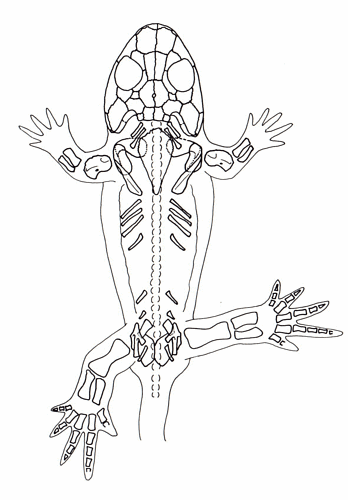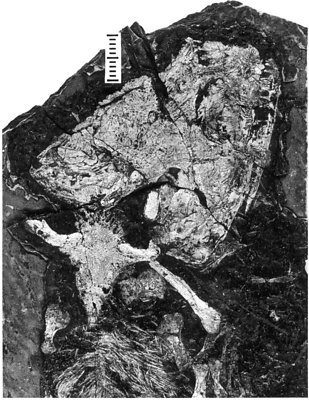Eucritta melanolimnetes
Jennifer A. Clack
Introduction
Eucritta melanolimnetes is a recently described species of tetrapod from the Visean of Scotland. It is one of a range of tetrapods found at the East Kirkton Quarry near Edinburgh. Other taxa include anthracosaurs, temnospondyls, stem amniotes and aistopods, and they represent the earliest known terrestrial tetrapod fauna. Eucritta shows a mixture of temnospondyl-like (eg. wide otic notch) and anthracosaur-like (eg. closed palate, girdle features) characters, but also shows incipiently the anterior embayment of the orbit found in baphetids. It clusters with baphetids in phylogenetic analyses (eg. Clack 1998, 2001, Ruta et al. 2003), as the basalmost member of the clade.


Reconstruction of the skeleton of the holotype specimen of Eucritta melanolimnetes (UMZC T.1347). See Clack (2001). © Jennifer A. Clack
References
Clack, J. A. 1998 A new Early Carboniferous tetrapod with a mélange of crown group characters. Nature 394: 66-69.
Clack, J. A. 2001 Eucritta melanolimnetes from the Early Carboniferous of Scotland, a stem tetrapod showing a mosaic of characteristics. Trans R. Soc. Ed. 92, 75-95.
Ruta, M., Coates, M. I. & Quicke, D. L. J. 2003. Early tetrapod relationships revisited. Biological Reviews 78: 251-345.
Title Illustrations

| Scientific Name | Eucritta melanolimnetes |
|---|---|
| Reference | see Clack, J. A. 2001 Eucritta melanolimnetes from the Early Carboniferous of Scotland, a stem tetrapod showing a mosaic of characteristics. Trans R. Soc. Ed. 92, 75-95. |
| Specimen Condition | Fossil |
| Type | Holotype |
| Image Use |
 This media file is licensed under the Creative Commons Attribution-NonCommercial License - Version 3.0. This media file is licensed under the Creative Commons Attribution-NonCommercial License - Version 3.0.
|
| Copyright |
© Jennifer A. Clack

|
About This Page
Jennifer A. Clack

University Museum of Zoology, Cambridge, UK
Correspondence regarding this page should be directed to Jennifer A. Clack at
Page copyright © 2006 Jennifer A. Clack
 Page: Tree of Life
Eucritta melanolimnetes.
Authored by
Jennifer A. Clack.
The TEXT of this page is licensed under the
Creative Commons Attribution-NonCommercial License - Version 3.0. Note that images and other media
featured on this page are each governed by their own license, and they may or may not be available
for reuse. Click on an image or a media link to access the media data window, which provides the
relevant licensing information. For the general terms and conditions of ToL material reuse and
redistribution, please see the Tree of Life Copyright
Policies.
Page: Tree of Life
Eucritta melanolimnetes.
Authored by
Jennifer A. Clack.
The TEXT of this page is licensed under the
Creative Commons Attribution-NonCommercial License - Version 3.0. Note that images and other media
featured on this page are each governed by their own license, and they may or may not be available
for reuse. Click on an image or a media link to access the media data window, which provides the
relevant licensing information. For the general terms and conditions of ToL material reuse and
redistribution, please see the Tree of Life Copyright
Policies.
- First online 09 February 2006
Citing this page:
Clack, Jennifer A. 2006. Eucritta melanolimnetes. Version 09 February 2006 (under construction). http://tolweb.org/Eucritta_melanolimnetes/58012/2006.02.09 in The Tree of Life Web Project, http://tolweb.org/








 Go to quick links
Go to quick search
Go to navigation for this section of the ToL site
Go to detailed links for the ToL site
Go to quick links
Go to quick search
Go to navigation for this section of the ToL site
Go to detailed links for the ToL site